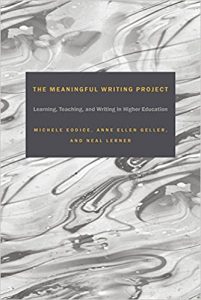Inclusive Practice
Assignments are not a neutral component to student experience in your class. Along with course syllabi, policies, rubrics, and more, assignments are part of a larger “ecology” of assessment—that is, systems of judging student learning and performance.[1] The assessment ecology of your course shapes not only what but how students learn, and it does so in ways that can be either inclusionary or exclusionary.
Consider the different ways in which an assignment’s purpose might be conceptualized (see Table 1):
| Exclusionary Purposes (gatekeeping) | Inclusionary Purposes (promoting learning) |
| Benchmark to appraise content proficiency only | Encouragement to demonstrate learning |
| Accountability to performative standards | Opportunity for critical self-evaluation |
| Competition with peers to achieve high rank | Conversation with instructor and classmates |
The purposes in the first column prioritize “gatekeeping,” which is the conscious or unconscious determination of whether students belong in an exclusive group of “top students” or “future professionals.” The purposes in the second column, on the other hand, prioritize student learning and inclusion over exclusion. An inclusive approach reorients the purpose of an assignment to ask not “How can this assignment weed out those who didn’t do the work?” but rather “How can this assignment help everyone in the class access, engage, and learn course concepts?”
Inclusive assignment design foregrounds an understanding of learning as a complex process abetted by multiple and recursive means of engagement. It also acknowledges the social and affective (as well as cognitive) dimensions of learning. In short, truly effective assignments help to ensure equitable education across a diverse student body.
-
Characteristics of Inclusive Assignment Design
Transparency
Effective assignments clearly state what the expectations are, how students can achieve those expectations, and why those expectations matter. This includes transparency around an assignment’s purpose, its genre, the steps needed to complete it, and criteria for success. You might also share support resources with students, such as the Writing Center, UW Libraries, or Design Lab.
Learn more: Transparency in Learning and Teaching in Higher Ed (TILT)
Engagement

Effective assignments show that research and writing are processes requiring ongoing conversation and recalibration. They do this by providing time and space for those conversations to take place, most commonly through opportunities for feedback and revision.
Learn more: The Meaningful Writing Project
Flexibility
Effective assignments offer options for how students might access and engage with major tasks. For instance, students might have the option to create a video or audio file rather than a written text, or they might have the option to choose which of three prompts to respond to. When possible, use more frequent, ungraded (“low-stakes”) assignments—an approach that has been found to reduce opportunity gaps.[2]
Learn more: Universal Design for Learning (UDL) Guidelines
Linguistic Justice
Truly effective—that is, inclusive and equitable—assignments support rather than penalize the diverse varieties of English used by our students. This can be accomplished by providing transparency around the myth of “standard” English (i.e. even formal, written English varies across contexts); opportunities for translanguaging, when possible; and feedback on conventions in English grammar, syntax, and idiom.
Learn more: Linguistic Justice: Black Language, Literacy, Identity, and Pedagogy
Click “next” in the bottom right corner to continue reading this chapter.
- Inoue, Asao B. Antiracist Writing Assessment Ecologies: Teaching and Assessing Writing for a Socially Just Future. WAC Clearinghouse. Fort Collins: 2015. ↵
- Eddy, Sarah L. and Kelly Hogan. “Getting Under the Hood: How and for Whom does Increased Course Structure Work.” CBE Life Sciences Education, 2014, Vol.13 (3): p.453-468. DOI: 10.1187/cbe.14-03-0050 ↵

